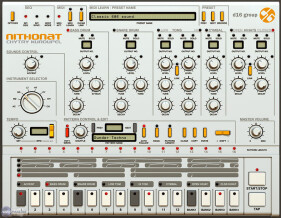D16 Group has announced that Nithonat has been released for Windows and Mac OS X in VST and AU plug-in formats and is now available for purchase for €79.
Demo versions are available. The final release version includes an updated GUI and a revised feature list since the original announcement (see below).
Nithonat is a described as a synthesized drum machine based on the classic Roland TR-606. The sound of this machine has been used by many artists over the years in the production of Electro, Hip-Hop, R’n’B, etc, the company said;
Nithonat is designed to emulate the original 606, however, since Nithonat is software based, D16 were able to enhance the original with extra functionality.
Control over the sound
On the original 606, the only editable sound parameter was volume. D16 has added to the original and as a result, Nithonat is equipped with extra controls which allow each sound to be shaped in ways which were not possible in the original machine, according to D16.
Nithonat is said to have characteristic hi-hat and cymbal sounds which are due to the emulated structure of the circuits in the original. The bass drum is described as having “unparalleled attack character and strong punch.” The snare sounds sandy.
Nithonat has a built-in internal sequencer. The tracks can be edited and modified with many useful functions. The clear GUI means that sequencer is easy to use.
In addition to having many internal sequencer modes, Nithonat can also be used as a sound module. All sounds and functions within Nithonat can be controlled from a host sequencer.
Features:
- Fully synthesized drum sounds.
- Additional parameters to get yet more control over the sound.
- Many ways of controlling the device:
- External mode (notes triggering the sounds).
- Internal sequencer (pattern mode).
- Internal sequencer:
- 8 banks with 12 patterns per bank.
- Each pattern up to 16 steps of length.
- Each pattern defined with one of four available measures.
- Shuffle mode.
- Global accent track.
- Tap mode.
- Chain mode.
- Shuffle (swing) and tempo values defined per pattern.
- Built in randomizer.
- Patterns import/export via human readable xml files.
- Two modes of synchronization:
- Precise synchronization to the host tempo.
- Synchronization to internal clock – tempo controlled in the range 30–300 BPM (+-0.1).
- Mutes/solos for each instrument (affect triggering not just the signal).
- Dynamic signal routing from instruments to outputs.
- Drum kits organised into groups.
- MIDI learn function.
- 64-bit internal processing.
Viewers of this article also read...
-
 Rent-to-own Ozone 9 and Neutron 3 together on Splice
Splice has bundled iZotope’s latest software audio processors and offers them at a lower price through their rent-to-own program.
Rent-to-own Ozone 9 and Neutron 3 together on Splice
Splice has bundled iZotope’s latest software audio processors and offers them at a lower price through their rent-to-own program.
-
 Over 150 free software tools to make music
Making music with your computer when you don't have a penny is possible. And to prove our point here you have 150+ free software tools many of which don't have anything to envy their paid counterparts.
Over 150 free software tools to make music
Making music with your computer when you don't have a penny is possible. And to prove our point here you have 150+ free software tools many of which don't have anything to envy their paid counterparts.
-
 Over 150 free software tools to make music
Making music with your computer when you don't have a penny is possible. And to prove our point here you have 150+ free software tools many of which don't have anything to envy their paid counterparts.
Over 150 free software tools to make music
Making music with your computer when you don't have a penny is possible. And to prove our point here you have 150+ free software tools many of which don't have anything to envy their paid counterparts.





